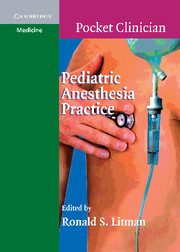Epidural Analgesia to Spinal Anesthesia
from PART THREE - REGIONAL ANESTHESIA
Published online by Cambridge University Press: 10 November 2010
Summary
INDICATIONS
▪ Postop: thoracotomy, laparotomy, procedures on hips and lower extremities
▪ Acute: chest & lower extremity trauma, sickle cell crisis
▪ Chronic: regional pain syndrome of lower extremities, pain from malignancy
PRE-PROCEDURAL ASSESSMENT
▪ Contraindications: history of bleeding disorder, spine abnormalities, previous spine surgery
▪ Informed consent
▪ Check for kyphoscoliosis or infection at sight of intended epidural placement.
▪ Detailed neurological exam to detect preexisting neuro deficits
PROCEDURAL MANAGEMENT
▪ Usually performe dunder general anesthesia in lateral decubitus position with adequate monitoring; if awake, sitting position may be used
▪ Caudal approach in neonate and young in fants; direct lumbar or thoracic puncture in older children
▪ Sterile prep and drape; operator wears sterile gloves, hat and mask
▪ Tuohy or Crawford needle, loss of resistance to saline or air
▪ Thread catheter 3–5 cm into epidural space.
▪ Aspirate for CSF or blood, administer test dose: lidocaine with epinephrine 0.1 mL/kg (max 3 mL) to rule out intravascular/intrathecal placement. Look for T wave amplitude elevation, tachycardia, hypertension, lower extremity weakness (conscious pts).
▪ Start epidural infusion in OR. Bolus prior to infusion. Supplement with IV opioids as needed.
▪ Children <8 yrs rarely develop hypotension; treat with fluids and/or vasopressors.
POST-PROCEDURAL CONCERNS
▪ Examine pt for adequacy of sensory block, particularly if complaining of pain.
▪ Bolus with or without increasing hourly infusion rate may be used to improve analgesia.
▪ Monitor cardiorespiratory parameters and pain scores on regular schedule.
[…]
- Type
- Chapter
- Information
- Pediatric Anesthesia Practice , pp. 214 - 216Publisher: Cambridge University PressPrint publication year: 2007

